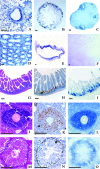Loss of the mouse ortholog of the shwachman-diamond syndrome gene (Sbds) results in early embryonic lethality
- PMID: 16914746
- PMCID: PMC1592835
- DOI: 10.1128/MCB.00091-06
Loss of the mouse ortholog of the shwachman-diamond syndrome gene (Sbds) results in early embryonic lethality
Abstract
Mutations in SBDS are responsible for Shwachman-Diamond syndrome (SDS), a disorder with clinical features of exocrine pancreatic insufficiency, bone marrow failure, and skeletal abnormalities. SBDS is a highly conserved protein whose function remains largely unknown. We identified and investigated the expression pattern of the murine ortholog. Variation in levels was observed, but Sbds was found to be expressed in all embryonic stages and most adult tissues. Higher expression levels were associated with rapid proliferation. A targeted disruption of Sbds was generated in order to understand the consequences of its loss in an in vivo model. Consistent with recessive disease inheritance for SDS, Sbds(+/-) mice have normal phenotypes, indistinguishable from those of their wild-type littermates. However, the development of Sbds(-/-) embryos arrests prior to embryonic day 6.5, with muted epiblast formation leading to early lethality. This finding is consistent with the absence of patients who are homozygous for early truncating mutations. Sbds is an essential gene for early mammalian development, with an expression pattern consistent with a critical role in cell proliferation.
Figures





References
-
- Aggett, P. J., J. T. Harries, B. A. Harvey, and J. F. Soothill. 1979. An inherited defect of neutrophil mobility in Shwachman syndrome. J. Pediatr. 94:391-394. - PubMed
-
- Bodian, M., W. Sheldon, and R. Lightwood. 1964. Congenital hypoplasia of the exocrine pancreas. Acta Paediatr. 53:282-293. - PubMed
-
- Boocock, G. R., J. A. Morrison, M. Popovic, N. Richards, L. Ellis, P. R. Durie, and J. M. Rommens. 2003. Mutations in SBDS are associated with Shwachman-Diamond syndrome. Nat. Genet. 33:97-101. - PubMed
Publication types
MeSH terms
Substances
Grants and funding
LinkOut - more resources
Full Text Sources
Molecular Biology Databases
